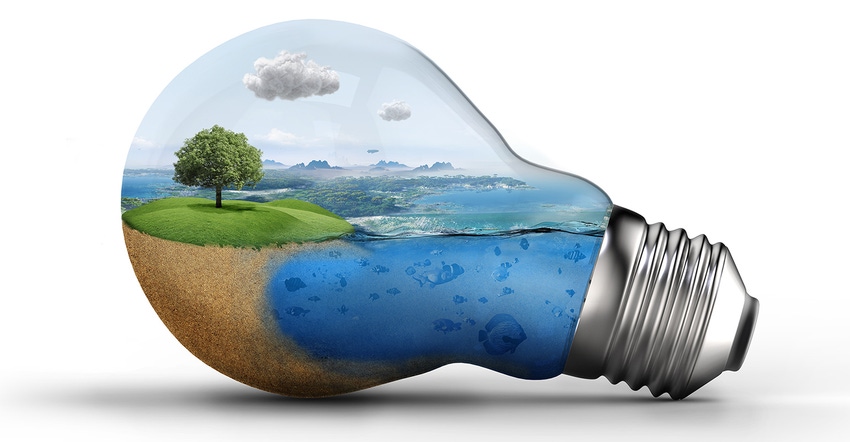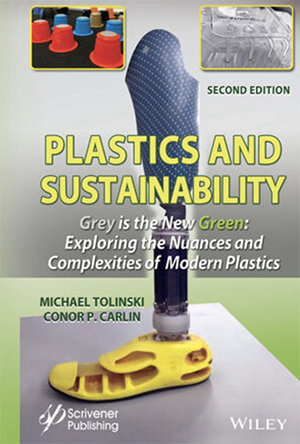Chapter and Verse on Plastics and Sustainability
A new edition of "Plastics and Sustainability — Grey Is the New Green: Exploring the Nuances and Complexities of Modern Plastics" gets to the heart of the matter in its preface: "Do plastics actually threaten our future?"
July 8, 2021

|
Now, here’s a book that everyone and anyone involved in plastics should read: Plastics and Sustainability – Grey Is the New Green: Exploring the Nuances and Complexities of Modern Plastics by Michael Tolinski and Conor P. Carlin (John Wiley & Sons Inc.; Scrivener Publishing LLC; 2021). It sticks to the science, and science is what we need more of rather than hype. The primary question is asked in the preface: “Do plastics actually threaten our future?”
When the facts are examined, we are told that only 4 to 6% of crude oil is currently converted into plastics, though the figure is rising. In the context of the average Western household, packaging represents a mere 1.7% of that unit’s carbon footprint, with home heating, electricity usage, and transportation accounting for almost 50%. With all of that taken into account, it becomes difficult for us in the industry, who depend on science, to figure out why plastics are on the front lines of this war against CO2 and climate change. (I won’t discuss the science of those two things in this review.)
It is probably the visibility and ubiquity of plastics in the environment that make it a good target. No one is going to rail against electricity (although that’s coming), especially those of us in Arizona in the summertime. “More than ever, plastics are front and center in the public eye, for better or for worse, with a vigorous debate underway about how to deal with the challenges posed by the complex and amazing long-chain molecules we know as polymers,” concludes the preface.
The book is an easy read for those with a basic knowledge of polymers. Those who are more advanced, such as scientists and engineers, might find the book a bit too elementary, but then they are not the ones who need convincing of the benefits of plastic.
The social issues surrounding plastics.
The first chapter takes on the social issues of plastics, including the great plastic shopping bag controversy that has many cities and towns across America in turmoil. It asks whether or not consumers really are as interested in sustainability as big corporations say they are. Sustainability is also very controversial. Many people aren’t even sure what that term means! Is the climate really changing as it never has before? (Don’t look for the answer in this book. As the authors point out, “This book is not meant to verify and/or support either those who agree or disagree with various global warming projections.”)
The second chapter, “Plastic Life Cycles,” gets into the heart of sustainability, including life cycle assessment (LCA), which “requires addressing all inputs and outputs (energy and materials) involved in the production, use, and disposal of a product.” You can’t discuss plastic life cycles without getting back into the “green” thing, and the myriad complexities surrounding the disposal segment of this argument. From a science viewpoint, this chapter teaches you how to do an LCA, including a life cycle inventory.
“The LCA process requires identifying all material flows at each state of a product’s production,” explain the authors. “This ‘life-cycle inventory’ lists and quantifies all materials that are present in the product, or that are required or produced in its processing, use, or disposal.” Included is a section on bio-based plastics, including the pros and cons of their use.
The next chapter, “The Grave: Disposal, Recycling and Biodegradability,” is thorough and detailed, and addresses something that everyone – plastics detractors and supporters – should keep top of mind.
“Polymer Properties and Environmental Footprints” is the third chapter and is quite extensive — about 60 pages including the reference section — in its scientific explanation of the various polymer materials. However, even if you’re a novice in plastics it’s easily readable and understandable.
After you’ve read about polymer materials and properties, you can move on to “Applications: Demonstrations of Plastics Sustainability” in chapter four. That will take you into the next chapter, “Design Guidelines for Sustainability” and “the six green design principles and guidelines for plastic parts.”
Many facets affect material selection.
Chapter six, “Sustainable Considerations in Material Selection,” provides a “decision-making process for selecting materials,” which Tolinski and Carlin point out is never one-size-fits-all. "Each application’s requirements will differ as will each company’s priorities when selecting materials.” Like previous chapters, this one is very thorough, providing the basics of materials, their properties, and best-use applications, using lots of charts and graphs.
Now that you’ve gone through the material properties and selection processes, you’re ready for “Processing: Increasing Efficiency in the Use of Energy and Materials.” This chapter gets into the recycling process, including mechanical and advanced recycling.
The final chapter, “Conclusion: Grey Is the New Green,” looks at future trends including market growth; the cost and availability of fossil fuel needed for traditional polymers; alternative feedstock trends, including some commentary on the food vs. fuel debate; and more as the authors explore a “truly post-industrial age for plastics.”
The future of chemical recycling.
That future should include advanced, aka chemical, recycling technologies that are expected to increase the conversion of difficult-to-recycle #3 to #7 plastics into fuel, base chemicals such as MEG and naphtha, and more. Tolinski and Carlin mention a few of the nearly 35 players in this field, such as Loop Industries, noting that it has come under scrutiny recently by Hindenburg Research; Danimer Scientific, which also has been under investigation but has had “industrial-scale” success, according to the authors; and Italy’s Bio-On, which announced bankruptcy on Jan. 3, 2020 with its assets sold at auction in March of this year. All of this means that the future of actual production at commercial scale for materials resulting from these technologies has yet to be realized.
As for the future of recycling bio-based plastics, which will become “a more available option in more markets,” according to the authors, the infrastructure needed to “manage end-of-life issues will have to be developed.” Recycling generally has not generated a lot of confidence among consumers and especially the anti-plastics crowd. Tolinski and Carlin take a brief look at the many controversies surrounding plastic bans, particularly those of various single-use plastics, including thin-film plastic bags, and what all of this means for the future of plastics sustainability.
I can recommend this second edition of “Plastics and Sustainability” as a book that offers a solid education rooted in the science of plastics — plastics naysayers would do well to read it before they begin bashing plastics.
About the Author(s)
You May Also Like





